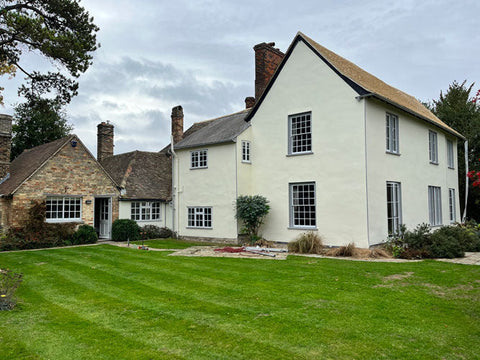If you’re the proud owner of a period property, a listed building, or both, choosing authentic heritage paint colours and finishes is about more than just good taste.
It’s a way of honouring your home’s unique story, preserving its charm, and adding your own chapter to its history. In the case of listed buildings, design isn’t your only consideration. You may have a legal duty to use a colour that’s appropriate and in keeping with the building’s heritage.
This guide looks at what heritage paint is, why it is important to your home decor, and what types of paint are best to use in old houses. We’ll also touch on planning rules for listed buildings, although you should always check the regulations in your local area for yourself. They can vary depending on where you live.
What Are Heritage Paint Colours?
Heritage paint colours are palettes drawn from the shades that would have been used in British homes during different architectural periods. From muted Georgian tones, to rich Victorian paint shades and elegant Edwardian styles. Heritage paints create a timeless and luxurious style which will complement your home without you needing to live in the past.
Heritage paint colours are historically inspired palettes designed to reflect the hues used in British homes across different architectural periods — from Georgian restraint to Victorian richness and Edwardian elegance.
Here at Greenshop Paints we’re offering colour ranges developed in collaboration with English Heritage, ensuring accuracy in tone and historical context. Developed by Graphenstone, they offer 24 carefully developed colours that suit traditional buildings and complement period features.

Pictured: Graphenstone Entrance Hall Blue - a bold blue inspired by the palette in the entrance hall at Kenwood House. The property is a Neoclassical design by famous architect Robert Adam.
See Also: Heritage Paint Colours inspiration guide.
Heritage colours lend a timeless elegance to your decor. Think sage green, deep oxblood, oxford blue, and muted stone shades that reflect centuries of architectural evolution.
Do I Need Planning Permission to Paint a Listed Building?
Most listed buildings do not need permission to paint the interior of the property. However, If you wish to paint the exterior of a listed building, or any building located in a conservation area, you may need to apply for planning permission.
Even if your home is not listed, being in a conservation area can impose restrictions on exterior paint colours, finishes, and the types of fixtures and fittings used. For example, guttering and fascias. Work which may change the character of a building of historical or architectural importance might require a planning application to approve works. There have been several cases of homeowners having to change the colour of a freshly painted home back to the original scheme when the council got involved.
Examples of when exterior painting or other work would likely require listed building consent:-
- Colour changes.
- Painting a previously unpainted exterior.
- Altering a finish which would change the character of the building.
- Removing paint to expose stone underneath.
- Using modern render or other building material on exterior surfaces.
Always check with your local planning officer before starting work, especially for Grade I or Grade II listed buildings. Grade II buildings are more common and have slightly more flexibility, but still require research before breaking out the paintbrushes.
You may also wish to consult Historic England information. Their range of guides for owners of listed buildings wishing to make changes to their homes is comprehensive.
See: A Guide for Owners of Listed Buildings - Features answers to the most commonly asked questions posed by those wishing to renovate period properties.
Why Breathable Paint Matters for Heritage Buildings
Period homes were built using construction materials and methods that allowed the building to breathe. Choosing a breathable paint is a heritage friendly option which can protect your home from damage.
Breathable paint for old houses is vital to keep the structure of the building in good condition. Old houses, particularly those built before 1920 used materials like lime plaster and solid brick. These were designed to let moisture naturally evaporate.
Modern, non breathable paints can trap moisture inside the walls of your home causing damp, mould growth and even structural damage if applied over traditional lime plasters.
Breathable paints like limewash or silicate based paints allow water vapour to escape. This helps your home function as originally intended, and remain a dry and healthy space for your family.
Heritage Paint Colours by Period
The Victorian and Edwardian periods are most commonly searched for by homeowners looking to create an authentic period look.
Victorian Paint Colours
Victorian homes featured rich dark shades that made a statement. Deep greens, burgundy, slate blue, and dramatic tiles and woodwork.
You can evoke the Victorian period by choosing a lighter shade of original paint colours. Many find authentic Victorian Colour Schemes somewhat overbearing.
Victorian Front Door Colours
Popular choices of the era include oxblood, brunswick green, and navy blue — usually in a gloss finish to suit the decorative style of the era.
Edwardian Paint Colours
The Edwardians favoured lighter, more calming interiors. Think soft whites, dusky pinks, and pale greens. Exteriors were often more restrained too.
Edwardian Front Door Colours
Popular Edwardian front door shades include heritage sage green, sky blue, and muted greys, often paired with stained glass or simple ironmongery.
Heritage Colours for Interiors
Inside period homes, it’s not just about colour. The finish and atmosphere created by the paint can be just as important. Matte and chalky finishes replicate the original look and feel of traditional paints.
Popular choices:
- Sage green in dining rooms or hallways.
- Off-white and ivory in Georgian style spaces.
- Terracotta and stone shades in rustic cottages.
Final Tips Before You Paint
- Check for listing restrictions and contact your local council if in doubt.
- Test samples on different walls and under various lighting conditions.
- Choose breathable, historically accurate paints to protect your home’s fabric and legacy.
Match colours to your home’s period, or choose a more contemporary version of a historical palette.
Natural Paints For True Period Charm
Here at Greenshop paints we can offer a range of natural paints highly suited to heritage homes and buildings. We offer breathable paints formulated from traditional ingredients without compromising on durability and quality of finish. Our Graphenstone English Heritage range was produced in partnership with English Heritage.
Available in 24 stunning colours reflecting the tones and colours that feature in some of the finest heritage properties around the UK. The range offers Exterior and Interior Lime emulsions, eggshell for wood, trim, and walls, and an ultra matt emulsion for true period charm.
Do please consider ordering one of our free paint charts, or very reasonably priced paint colour swatches which you can stick to the wall, and reuse as many times as you like. You can also browse our range of paint colours by shade.





